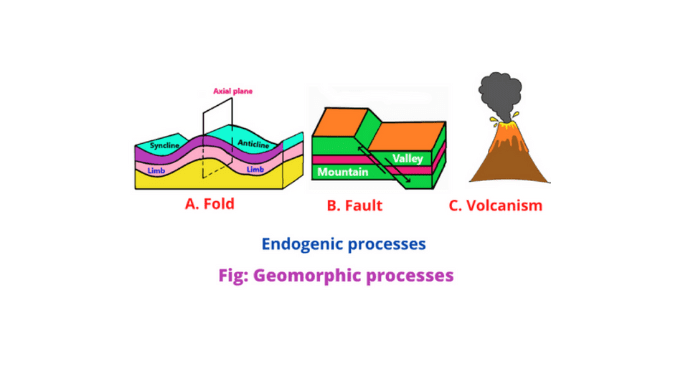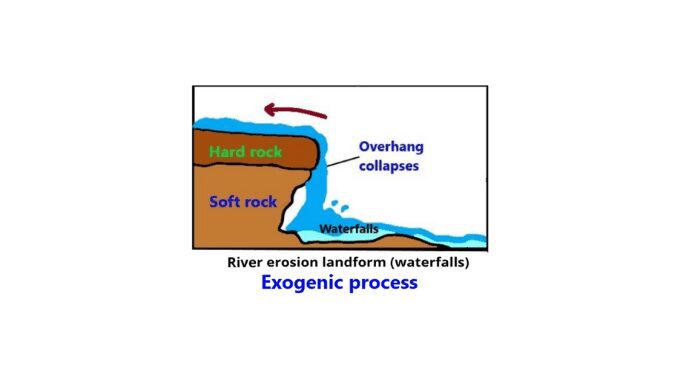Introduction
Geomorphic process is a process that describes how different landforms on earth are formed. It changes the configuration of the earth’s surface, which is caused by physical and chemical action on the materials present in the earth. Below is a discussion of the definition and types of geomorphic processes.
The topography of the land and seafloor of the earth is varied. All the landforms of land and water bodies change with time. Today’s plains may have been parts of oceans or mountains in the past. That is why the remains or fossils of marine animals are observed in the peaks of the Himalayas, Rocky, and Andes mountains.
Moreover, by analyzing the rocks and soil of these mountains, scientists have found that the mountains are formed from the sea floor. That is to say, over the ages, mountains, plains, plateaus, etc. have been raised under the influence of the orogenic movement. The process by which this uplift occurs is called the geomorphic process (1) & (3).
Geomorphic process definition
The processes by which landforms change and evolve through physical and chemical changes are called geomorphic processes (3).
Types of geomorphic process
The surface of the earth is constantly changing. The energy required to change the surface changes either slowly or abruptly or both. That is, the geomorphic process is mainly divided into 2 types. Namely endogenic and exogenic processes. Their different types are described below.
- Endogenic process
- Exogenic process
1. Endogenic process

Meaning
The endogenic word comes from two Greek words endo and genic. The word endo comes from ‘endon’, which means ‘internal’, and the genic word comes from ‘genesis’, which means origin.
Definition
Endogenic processes are the changes in landforms that occur through contraction, expansion, uplift, subsidence, etc. of the earth’s core under the influence of convection currents generated in the atmosphere (1) & (5).
Facts
1. Endogenic processes are the mechanism by which internal geologic forces act to form primary landforms.
2. The force which is involved in this process is caused by changes in the physical and chemical properties of the elastic material within the inner sphere.
3. These processes act on the crust both suddenly and slowly over long periods of time.
4. In this process, the relative movement of the crust occurs and the main landforms that form are continents and oceans or mountains, plateaus, and plains.
5. Endogenic processes are responsible for the formation of the earth’s relief and the formation of important mineral resources.
6. This process plays an important role in maintaining other structural features of the earth’s crust (3) & (5).
Types of endogenic processes
There are two types of endogenic processes. These are as follows
1. Slow movement or diastrophism
Definition
As a result of intense heat and pressure in the earth’s interior, convection currents are created under certain conditions. Then a strong force is generated in the earth’s interior. The force originating from the earth’s interior that deforms the earth’s crust or the continental tectonic structure on the surface is called diastrophism.
Description
1. Diastrophism is a type of earth movement that occurs slowly.
2. It acts under the crust for thousands or millions of years.
3. Mountains, plateaus, plains, faults, folds, etc. are formed by this process.
4. The intensity of such earth’s movement is low.
5. Diastrophism cannot be measured with instruments.
6. It is a type of earth’s movement of deformation of the earth’s crust that involves folding and faulting.
7. Vertical and horizontal movement of the land occurs in this earth movement.
8. It cannot be felt all the time.
9. This type of earth‘s movement covers the movement of solid crust material.
10. It is considered a part of Geotectonics.
11. As a result of diastrophism different parts of the crust change, evolve and new landforms are formed (2) & (3).
Types of Slow movement or diastrophism
a. Epeirogenic movement
Definition
Earth’s movement that acts vertically on the earth’s surface and causes uplift or subsidence of the crust is known as epeirogenic movement. This type of movement is organized widely across the continent hence it is called epeirogenic movement.
It acts vertically along the radius from the earth’s center to the surface. As a result, a part of the crust is upward or downward vertically. Then the bedrock is upward or downward. When this earth’s movement occurs over vast areas of the continent, parts of the continent upward from the sea or downward to form oceans. This process is known as epeirogenic movement (4) & (6).
Types
Upward movement
Upward movement is a type of movement that occurs when a continent or a coastal region gradually rises upwards under the influence of a heavy epeirogenic movement (1).
Downward movement
Downward movement or submergence occurs when a continent or a coastal region gradually moves downward under the influence of a heavy epeirogenic movement (1).
b. Orogenic movement
Definition
As a result of the earth’s movement, the rock layers are folded and Fold Mountains are formed, and when the compressive force is strong, faults are created, it is called orogenic movement. This type of movement works horizontally on the surface, so it is also called horizontal movement. In fact, it is tangential to the elliptical surface of the earth (3).
Orogenic movement acts horizontally or tangentially on the surface. As a result of this movement, two land areas move towards each other (convergence) and somewhere they move in opposite directions (divergence).
Features
1. Orogenic movement takes place over a wide and vast area.
2. Horizontal displacement of the crust occurs in this earth’s movement.
3. In the orogenic movement, the force acts horizontally along the tangent.
4. Such earth’s movement results in the compression of rocks and folds.
5. Fold Mountains are formed as a result of orogenic movement.
6. Formation of folds in the crust due to the effects of this earth’s movement.
7. This type of earth movement occurs along the tangent of the earth.
8. Here the forces act horizontally towards each other.
9. This earth’s movement impact only resulted in the emergence of the Fold Mountains. However, due to extreme pressure, many thrusts were created throughout the hilly areas (3) & (4).
Causes
Causes of orogenic movement are
- Earth’s interior is molten and unstable at high altitudes. As a result, the convection currents that are created in the interior of the earth, when they create horizontal pressure on the surface, the rock layers are folded and mountains are formed
- The substances inside the earth are in a molten state. As such material cools by radiating heat, the surface of the crust contracts.
- Folds are formed by tectonic pressure in the thick sedimentary layers accumulated in the geosyncline. For example, the Himalayas and the Alps were formed by the strong pressure of Gondwanaland and Angara land on the sediments deposited in the Tethys Sea.
- At present, scientists attribute the horizontal movement of continent-continent or continent-ocean plates as the cause of the orogenic movement.
c. Sudden movement
Definition
Sudden movement is when suddenly movement occurs far below the crust under the influence of internal forces.
In fact, this earth’s movement is the cumulative effects of various processes occurring in the earth’s interior. That is, although this earth’s movement takes place quickly on the surface, inside, its preparatory phase lasts for many years (1) & (4).
Fact
1. The earth movement that occurs suddenly or momentarily under the influence of internal forces is called sudden movement.
2. This earth movement is temporary, there is no fixed time limit. The UNA usually acts vertically on this stirring surface.
3. The energy and earth movement can be measured with the help of sensitive and delicate instruments.
4. Although predominantly destructive, this force has little effect on surface modification.
5. Due to the impact of the eruption, different types of volcanic eruptions inside the earth, landforms like volcanoes, caldera, etc. on the surface, and due to earthquakes, various types of landforms change.
6. It is perceptible.
7. The effect of energy is less in the case of surface changes (2) & (3).
Types of sudden movement
- Volcanism
Volcanism is the special mechanism by which hot molten material or magma is released to the surface through a crack or hole in the crust. As a result of this volcanism, the dyke, lopolith, laccolith, sill, sheet, etc. are formed in the rock layers and volcanic mountains, volcanoes, etc. are formed on the earth’s surface (3).
- Earthquakes
Earth’s hard crust shakes suddenly for some time as a result of any disturbance in the earth’s interior. Such natural phenomena are called earthquakes.
Earthquakes usually last from a few seconds to 1/2 minutes. But some earthquakes last as long as 8 to 10 minutes. The powerful earthquake caused extensive damage to houses and property and many lives were lost. As a result of these earthquakes, faults, folds, lakes, joints, etc. are formed in the earth’s surface (3).
2. Exogenic process

Meaning
Exogenic word comes from two Greek words exo and genic. The word exo means ‘from outside’ or ‘external’ and the genic word comes from genesis’ which means ‘origin.
Definition
The processes by which erosion, transport, and deposition occur at the surface. As a result, different types of landforms are formed on the earth’s surface called exogenic processes (1) & (6).
Facts
1. Exogenic processes are very slow processes.
2. This process gets energy from the slope of the land which is created by geological processes (slope of gradient).
3. The energy which is required for these processes comes from the atmosphere and the sun.
4. These processes formed sedimentary rocks.
5. Exogenic processes refer to all the processes that are occurring at the earth’s surface.
6. Weathering, erosion, transportation, etc. are the primary exogenic processes.
7. It is also known as a destructive process (2) & (3).
Types
1. Weathering
Weathering is a natural process. This is the pre-formation process for soil formation. Through this process, the rock is broken into small pieces or crushed rock. The crust is made up of different rocks.
Weathering is the breaking or separation of rocks from the same place in different natural processes and chemical reactions under the influence of different elements of weather (3).
2. Erosion
Erosion is the process by which rock layers are broken down and moved by rivers, glaciers, wind currents, ocean waves, etc. (1).
3. Deposition
A deposition is an exogenic process where the sediments are carried out by wind, glaciers, groundwater, river, etc. (1).
Written By: Manisha Bharati
Q&A
1. Avalanches are what type of geomorphic process?
Avalanches are a type of exogenic geomorphic process.
2. What is geomorphic process?
All the natural and chemical processes that cause change and evolution of the earth’s surface are called geomorphic processes.
3. Which process is an internal geomorphic process?
The endogenic process is an internal geomorphic process.
4. The primary geomorphic processes at work on the landforms of the Atlantic periphery are what?
Glaciation is the primary geomorphic process at work on the landforms of the Atlantic periphery.
5. Which of the following is not an external geomorphic process?
Diastrophism is not an external geomorphic process.
Reference
1. Savindra Singh. Geomorphology. Pravalika Publications, Allahabad. Chapter 9: Earth’s movement. Page No: 158 to 169.

